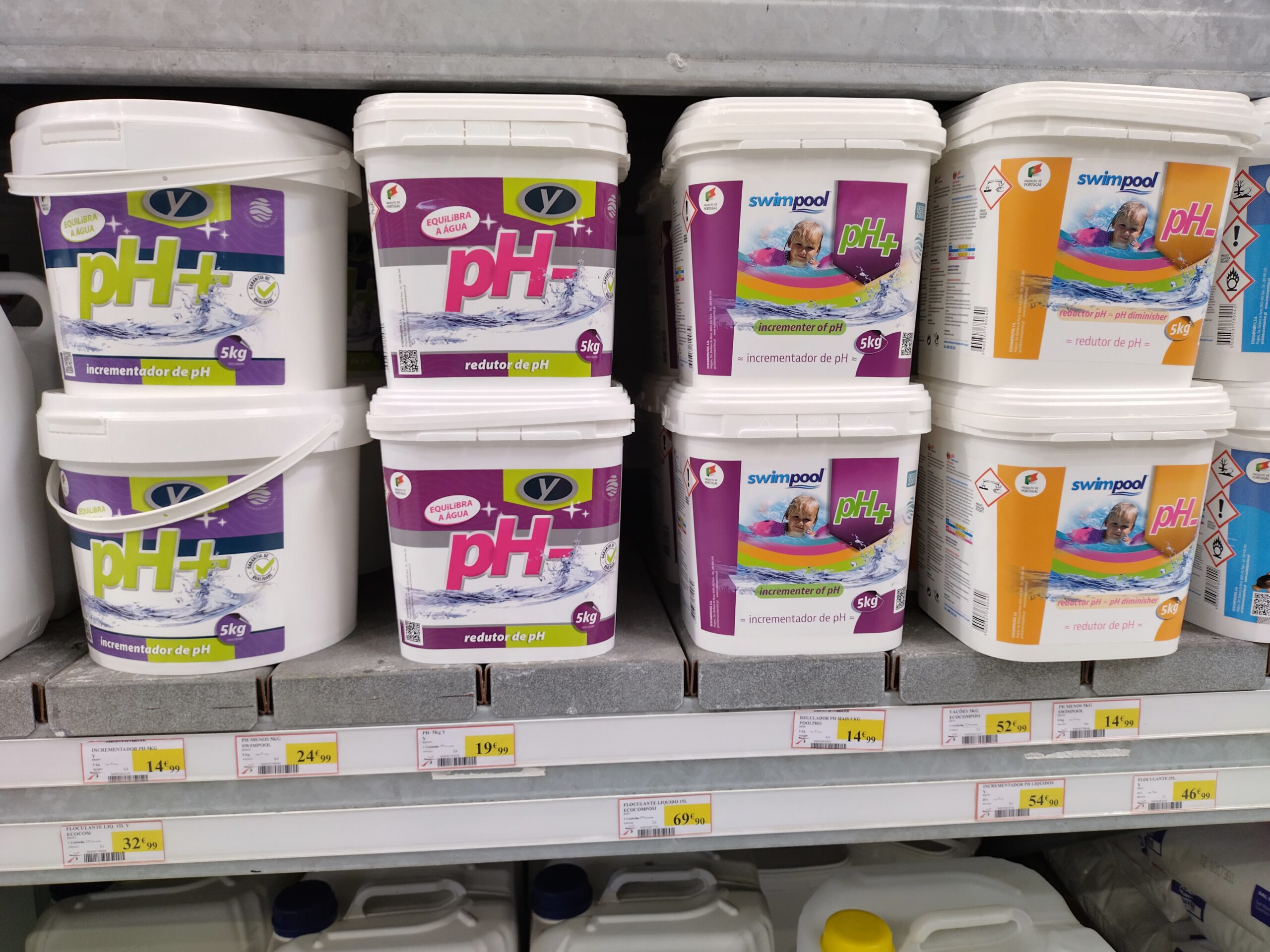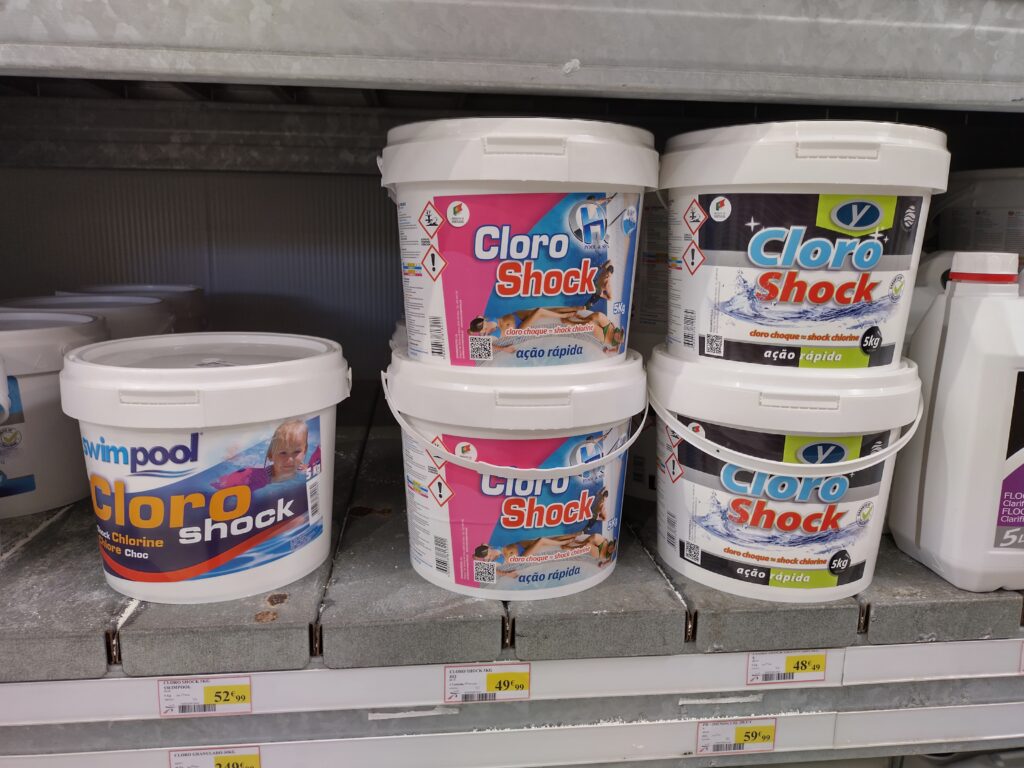The basic table for proper pool maintenance with in-depth explanations.
- Step 1, The Water Base:
- Salinity
- Hardness
- Cyanuric Acid
- Step 2, Acidity and Buffer Capacity:
- pH
- Alkalinity
- Step 3, Disinfection capacity:
- Free chlorine
Table of Contents
The data table
| Item | Min. | Max. | Increasing (adding, sources) | Decreasing (removing |
|---|---|---|---|---|
| Salt | 4000 | 5000 | Salt | Partially drain pool and add tap and or rain water. |
| Hardness | 200 | 300 | Calcium chloride | Partially drain pool and add tap and or rain water. |
| Cyanuric acid | 20 | 30 | Pure cyanuric acid or combined with chlorine products. | Partially drain pool and add tap and or rain water. |
| Alkalinity | 80 | 120 | Sodium bicabonate | Decay over time, add hydrochloric acid |
| pH | 7.0 | 7.6 | Production of chlorine, add sodium bicabonate | Add hydrochloric acid |
| Chlorine | 1 | 3 | Turn on unit | Decay over time |
Minimum and maximum values in ppm – except for pH.
Important notes
- Don’t be fooled:
- That beautiful swimming pool with crystal-clear water may in reality be a poison pit full of pathogens.
- About health and safety: There is a serious responsibility on every pool owner.
- Make sure to fully understand this article.
- Never buy products whose chemical composition are not known.
- Examples: pH-plus, pH-min, stabilizer, chlorine granules and so on.
- In doubt? Ask for a safety sheet, it contains a specification of used chemicals.

- Use only the chemicals listed here.
- Provide good measuring devices, preferably two different versions for double checking from time to time.
- Always be extremely careful with chemicals, especially hydrochloric acid and chlorine products. Use gloves, protect your skin and eyes and never inhale the fumes of hydrochloric acid, keep as much distance as possible and work upwind.
If contact occurs, flush excessively and for a long time with water, seek fresh air, remove affected clothing. In case of inhalation, seek fresh air and seek medical attention immediately. - Have a basic understanding of how the swimming pool works:
- The dissolved salt, consisting of sodium and chlorine atoms, is split by the chlorine unit.
- The pure sodium reacts immediately to form sodium hydroxide (Na+OH–, pH increases).
- The pure chlorine gas dissolves in water to form hypochlorous acid (H+ClO–, pH decreases).
- The hypochlorous acid reacts with pollutants to form chloramines, which stink of chlorine, leaving the pool.
- The consumed chlorine will have to be periodically replenished with hydrochloric acid (H+Cl–).
- Therefore:
- Salt is the recycling medium and
- Hydrochloric acid is the pool’s “fuel”.
- The dissolved salt, consisting of sodium and chlorine atoms, is split by the chlorine unit.
- About concentrations:
- Know the size of your swimming pool in cubic meters (example 50 m3).
- PPM is Parts Per Million, based on weight.
- Examples:
- 4000 ppm salt is 4000 gram per m3 is 4 kg per m3.
- 30 ppm chlorine shocking with 14% sodium hypo chlorite solution means 30 grams pure sodium hypochlorite per m3 is 30grams*100%/14% = 215 grams, 0.215 liter solution per m3.
- For our 50 m3 swimming pool we need 4kg*50m3=200 kg salt and for shocking with 30 ppm we need 11 liter 14% bleach, sodium hypochlorite solution.
Groups, steps
The table contains three groups or steps:
- Ingredients salt, hardness (calcium salts) and cyanuric acid form the solid water base. Lowering levels can only be done by replacing water. This must therefore be in very good order before the steps below are carried out, regulated.
- Alkalinity and pH influence each other. Start increasing alkalinity with sodium bicarbonate to max. Then add hydrochloric acid to pH min. Check and repeat until correct values are reached. Finishing at slightly higher alkalinity in the beginning is not a problem, pH must be right.
- Free chlorine should fall within limits specified by chlorine unit manufacturer.
Topics, ingredients
Salt or salinity
Salt is the recycling medium for the production of chlorine.
For concentration, always consult the chlorine unit manufacturer’s manual. Too little restricts the chlorine unit from producing chlorine and too much is harmful to the pool – corrosion.
Add salt to the bottom and do not use the chlorination unit until the salt is completely and evenly dissolved: run the pump and wipe with a broom if necessary. Never(!) pour salt directly into skimmers.
Hardness
In particular, calcium and magnesium salts make water hard.
Too soft: metals and grouting are prone to erosion.
Too hard: cloudy water, irreversible lime deposits on tiles, joints and in pipes, algae growth.
Incorrect hardness can result in major damage. Rainwater is extremely soft, well water is often too hard.
Increasing hardness by adding calcium chloride is an option but beware of fancy calcium chloride products that contain cyanuric acid.
Cyanuric acid
Cyanuric acid does not leave the pool by itself. It protects free chlorine from UV radiation.
However, both a deficiency and an excess will result in reduced, to near-zero, disinfectant capacity.
Typical “fancy name” chlorine-containing products like “conditioner” and “stabilizer” contain substances that are also a source of cyanuric acid, allowing the concentration to go too high unnoticed. These include substances such as “sodium troclosene”, “dichlor” and “trichlor”. On jars of miracle cures, the ingredients are often listed with unidentifiable names. Ask the supplier for a safety sheet of the product.

There are many different opinions on concentration. However, aiming for a minimum of 20 ppm and a maximum of 30 ppm is justified and always keep it under 50ppm. WHO labels 100 ppm as poison.
Alkalinity
Alkalinity ensures that pH does not fluctuate too much and remains stable.
It compensates for the impact of a heavy rainfall or the continuous production of chlorine on the pH.
Sodium bicarbonate increases alkalinity. Chemically, sodium bicarbonate is a buffer. See further comments on pH below.
pH, Acidity
Acidity. A pH of 7 is neutral, lower is acidic and higher is alkaline.
Too low a pH endangers health because free chlorine is less effective and pathogenic chlorine compounds are formed. A characteristic is red eyes after swimming and a smell – of trichloramine in particular.
Limits are often regulated by law. A Danish study states that a pH range of 7.0 and 7.2 is optimal. (Cache-link)
The pH can fluctuate enormously if alkalinity is not properly regulated. Chlorine production always results in a pH rise over time. Too low a pH, lower than 6.8, requires immediate action due to health risks. Never let the pH rise beyond 7.8 for the same reasons.
In principle, use only sodium bicarbonate to raise the pH and use only hydrochloric acid to lower the pH. Sulphuric acid is not an alternative to lower pH; sulphates do not leave the pool.
Chlorine
FC, free chlorine. This is the actual disinfectant. The chlorine unit produces chlorine gas that dissolves in water to form hypochlorous acid. The hypochloric acid destroys bacteria, viruses and algae.
Important: hypochloric acid disinfects only if all other measured values are in the right range – especially cyanuric acid and pH.
Low and high chlorine concentrations can usually be explained by too much or too little cyanuric acid or a completely derailed pH. In such a situation, the disinfecting effect of hypochloric acid is almost completely nullified – even if the chlorine concentration is enormously high.
The typical smell of chlorine in a swimming pool is not caused by hypochlorous acid but by chloramines formed when pollution reacts with hypochlorous acid. This can be seen as a bad sign because there is apparently pollution and it can be seen as a good sign because the pollution is cleaned up.
If everything works well then there is a balance between pollution and formation of hypochlorous acid for clean-up. However, heavy pollution (think sunscreen, leaves), hot summer days and lots of sunlight (UV) can upset that balance, even when the chlorine unit is running at maximum production. Algae growth is a good indicator of imbalance.
Such an imbalance can be broken by “shocking” the pool. Shocking is best performed with a single dose of sodium hypochlorite, just pure bleach. 10 ppm to 30 ppm in that case is enough to destroy algae and restore the normal process.
Swimming in concentrations higher than 10 ppm of chlorine is not a good idea.
Measuring chlorine concentration only makes sense if all other values are in order.
Make sure to know the free chlorine limits specified by chlorine unit manufacturer.
Check the chlorine unit from time to time. Descaling can be performed with hydrochloric acid. Never use concentrations higher than 10% for this.